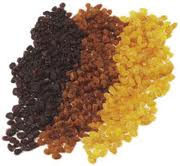
Raisin processing
Raisin processing
The dried grapes are moved from the storage bins to the processing plant. Raisin processing
Here they are emptied out onto a conveyor line and mechanically modified. The residual sand and other debris are first removed by running the raisins on a fine mesh screen while air is blown on them. Immature fruit is removed by suction devices.
Next, the raisins are separated from the bunch stem by shaking. The cap stems on each raisin are removed by being passed through two rotating conical surfaces. If there are seeds in the raisins, they are mechanically removed.
When all these processing steps are completed, the raisins are run through a series of mesh screens to sort them according to size.
At this point, the raisins can be put into a variety of packaging.
These range in size from small half-ounce cardboard containers for individual consumption to 1,100 lb (499.4 kg) containers for industrial use. Each package is run through metal detectors, in order to detect any unwanted metal particles, and then checked for the appropriate weight. Raisin processing
They are packed onto trucks and shipped to customers.
The whole process of receiving the raisins at the factory, processing them, and putting them into packaging takes about 10 minutes.
Quality Assurance: Grading and Packaging
1. Rigorously Graded: Ensuring Quality at Every Level
Learn about the meticulous grading process that separates raisins based on size, color, and quality. Understand how this step guarantees a uniform and premium product for consumers.
2. Preserving Freshness: The Art of Raisin Packaging
Explore the packaging techniques employed to preserve the freshness and flavor of raisins. From airtight containers to innovative packaging, discover how raisins reach consumers in optimal condition.
Quality Unveiled: The Final Steps in Raisin Processing
Unveil the commitment to quality through rigorous grading and thoughtful packaging, ensuring that each raisin delivers a burst of flavor and nutrition.
Raisin processing
The dried grapes are moved from the storage bins to the processing plant. Raisin processing
Here they are emptied out onto a conveyor line and mechanically modified. The residual sand and other debris are first removed by running the raisins on a fine mesh screen while air is blown on them. Immature fruit is removed by suction devices.
Next, the raisins are separated from the bunch stem by shaking. The cap stems on each raisin are removed by being passed through two rotating conical surfaces. If there are seeds in the raisins, they are mechanically removed.
When all these processing steps are completed, the raisins are run through a series of mesh screens to sort them according to size.
At this point, the raisins can be put into a variety of packaging.
These range in size from small half-ounce cardboard containers for individual consumption to 1,100 lb (499.4 kg) containers for industrial use. Each package is run through metal detectors, in order to detect any unwanted metal particles, and then checked for the appropriate weight. Raisin processing
They are packed onto trucks and shipped to customers.
The whole process of receiving the raisins at the factory, processing them, and putting them into packaging takes about 10 minutes.
Quality Assurance: Grading and Packaging
1. Rigorously Graded: Ensuring Quality at Every Level
Learn about the meticulous grading process that separates raisins based on size, color, and quality. Understand how this step guarantees a uniform and premium product for consumers.
2. Preserving Freshness: The Art of Raisin Packaging
Explore the packaging techniques employed to preserve the freshness and flavor of raisins. From airtight containers to innovative packaging, discover how raisins reach consumers in optimal condition.
Quality Unveiled: The Final Steps in Raisin Processing
Unveil the commitment to quality through rigorous grading and thoughtful packaging, ensuring that each raisin delivers a burst of flavor and nutrition.